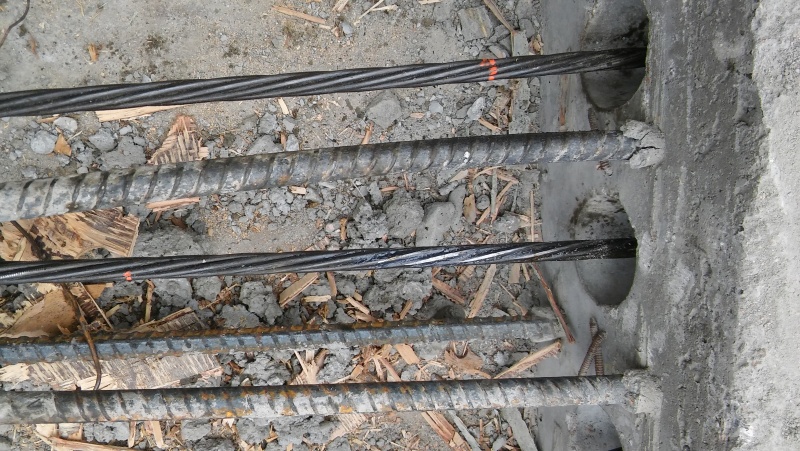SoleSteel
Structural
- Apr 24, 2015
- 11
Hi,
I'm working the construction administration on an elevated PT slab project as the EOR and I'm troubleshooting an issue in the elevated slab levels below grade. The elongations are coming out consistently low (between 10-17% low on cables between 50-125 feet). They are all single-end pulls. We've looked at several different causes and seem to be hitting dead ends everywhere (no pun intended). We visited the job site and the procedure they are using to stress the cables seems acceptable. We could still measure the stressing force output using a load cell to rule out the hydraulic rams being out of calibration.
One thing we noticed was that the oxidation from the stressed cables coming out of the slab was stripped on the top side of the cable to reveal the unoxidized metal. On some cables, the strands were stripped so much that their surfaces had actually gone from being round to being flat. I'm curious if anyone has ever seen this before. I'm hearing from a third party that this condition has occurred frequently on the project and I'm thinking that if something is providing additional friction for the PT cables as they are stressed, there is less force being put into the cables than is required and that can certainly lower the expected elongations. The only other thing I could think of was to take the the friction calculations to their limit. We ran our own friction calculations and we are able to bring the expected elongations lower, but only after maxing the wedge seating, angular coefficient, and wobble coefficient limits. I am not sure that it's the best way forward, but it's an idea.
I have a photo of the damage, but I unfortunately left my phone at home. I'll upload it as soon as I have a free moment.
I appreciate your experience and input! Please let me know if there's any additional information I can provide.
I'm working the construction administration on an elevated PT slab project as the EOR and I'm troubleshooting an issue in the elevated slab levels below grade. The elongations are coming out consistently low (between 10-17% low on cables between 50-125 feet). They are all single-end pulls. We've looked at several different causes and seem to be hitting dead ends everywhere (no pun intended). We visited the job site and the procedure they are using to stress the cables seems acceptable. We could still measure the stressing force output using a load cell to rule out the hydraulic rams being out of calibration.
One thing we noticed was that the oxidation from the stressed cables coming out of the slab was stripped on the top side of the cable to reveal the unoxidized metal. On some cables, the strands were stripped so much that their surfaces had actually gone from being round to being flat. I'm curious if anyone has ever seen this before. I'm hearing from a third party that this condition has occurred frequently on the project and I'm thinking that if something is providing additional friction for the PT cables as they are stressed, there is less force being put into the cables than is required and that can certainly lower the expected elongations. The only other thing I could think of was to take the the friction calculations to their limit. We ran our own friction calculations and we are able to bring the expected elongations lower, but only after maxing the wedge seating, angular coefficient, and wobble coefficient limits. I am not sure that it's the best way forward, but it's an idea.
I have a photo of the damage, but I unfortunately left my phone at home. I'll upload it as soon as I have a free moment.
I appreciate your experience and input! Please let me know if there's any additional information I can provide.


![[smile] [smile] [smile]](/data/assets/smilies/smile.gif)
![[medal] [medal] [medal]](/data/assets/smilies/medal.gif) . The person doing the de-tensioning is going to have to be close enough to get his hands in to get the old wedges out. Make sure they leave the wedges in place if they are going to need multiple bites to release all of the extension depending on the available jack travel!
. The person doing the de-tensioning is going to have to be close enough to get his hands in to get the old wedges out. Make sure they leave the wedges in place if they are going to need multiple bites to release all of the extension depending on the available jack travel!